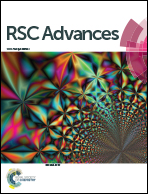Tuning the intramolecular charge transfer (ICT) process in push–pull systems: effect of nitro groups†
Abstract
The intramolecular charge transfer (ICT) process in donor–acceptor systems has tremendous importance in various physical and biological systems. Three nitrophenolate salts were synthesized and studied here. The ICT and π → π* transition processes were identified in these derivatives using UV-Vis spectroscopy and theoretical calculations. It was observed that by simple substitution with nitro groups, one can generate and control the ICT process by regulating the charge distribution over the molecule. While for a monosubstitute nitro derivative, only one ICT band was observed, additional ICT processes can be generated at will by introducing a second nitro group. The intensity of this second ICT channel can be regulated with introduction of a third nitro group. Further, the association constants and solvation processes for these potassium nitrophenolate derivatives were found to be drastically dependent on the number of ICT channels present in the molecule. Theoretical studies (MEP analysis) support the experimental observations presented here. The results show that by simply introducing additional acceptor groups to the system, one can tune the ICT band efficiently in a conjugate system.


 Please wait while we load your content...
Please wait while we load your content...